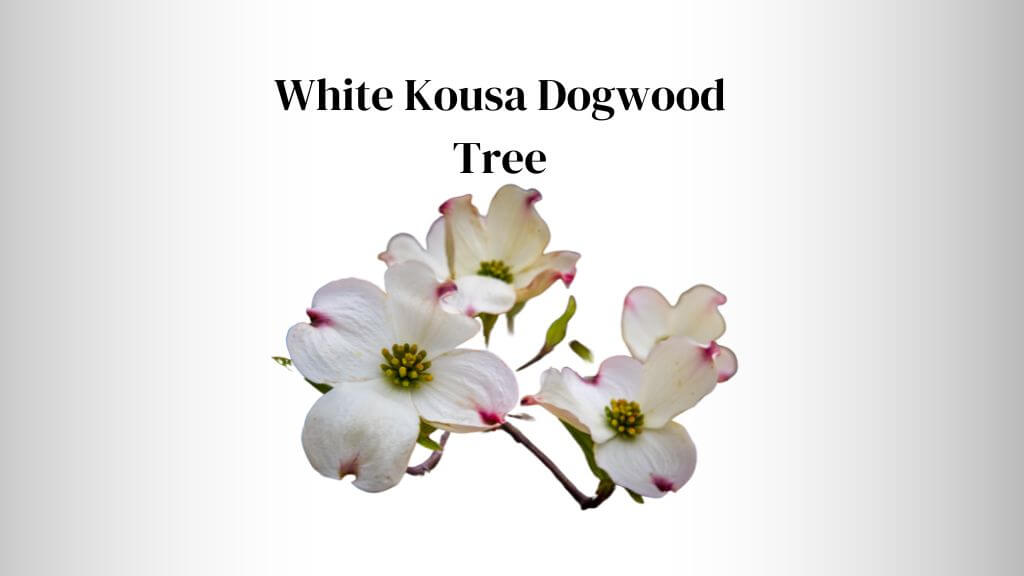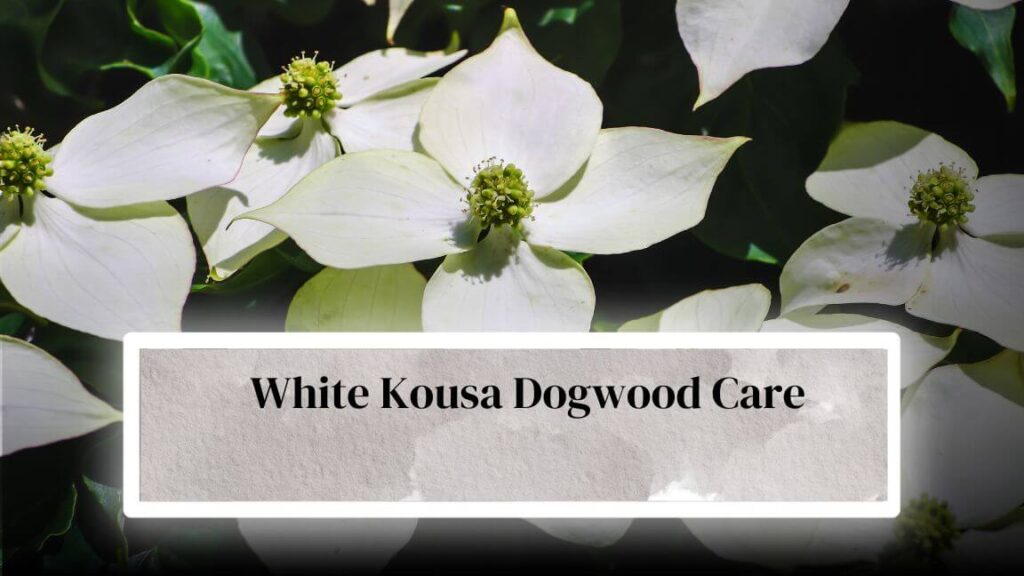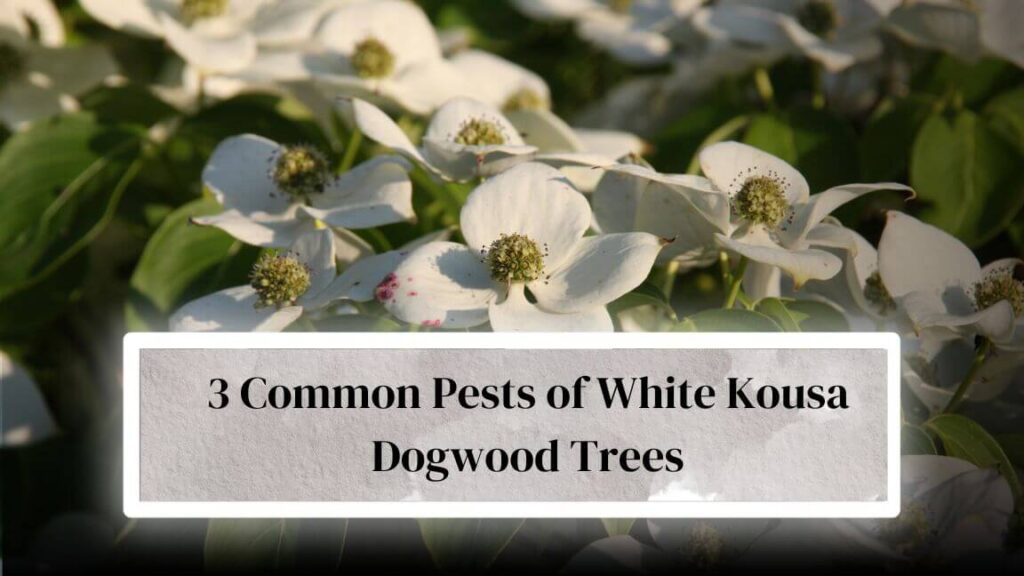
If you are a nature lover like me or love trees, you might have heard about the white Kousa Dogwood trees known for their stunning appearance. They are commonly found in many parts of the world, and that’s why here we will talk about it.
In this article, you will learn about White Kousa Dogwood’s geographical location and appearance, including bark, leaves, flowers, and fruits. Later, we will also talk about White Kousa Dogwood care & growth rate.
White Kousa Dogwood Tree
The White Kousa Dogwood tree is a deciduous tree known for its stunning white flowers. It is a small to medium-sized tree that belongs to the family Cornaceae and can grow up to 8-10 meters in height.
Since this specimen is native to East Asia, you can find white Kousa Dogwood trees in many parts of China, Korea, and Japan. It is also quite popular and found widely in other parts of the world, including North America, Europe, and Australia.
In the United States, you will likely find white Kousa Dogwood in the eastern and central parts. It is not only a very beautiful tree that is known for its ornamental value but also important for many reasons.
Firstly, this specimen is popular among landscapers and gardeners because of its beautiful appearance. I like adding a touch of elegance and beauty to my garden.
Suppose you want to consider adding one of the white Kousa Dogwood trees to your landscape. Other than this, the specimen is known for its medicinal properties also.
According to a study published in the Innovare Academic Sciences, White Kousa Dogwood trees’ bark and leaves contain anti-inflammatory and analgesic compounds.
The appearance of White Kousa Dogwood Trees
As I told you earlier, the White Kousa Dogwood tree, also known as Cornus Kousa, can grow up to 20-30 feet in height and spread up to 25 feet wide. It has a distinctive appearance and branches that grow horizontally, creating a layered look.
They also come with a broad, spreading canopy and a dense, layered growth habit. Another thing to note about their attractive appearance is their smooth and greyish bark with a unique texture, creating visual interest.
The bark of a white Kousa Dogwood tree peels off in small plates or scales, revealing a slightly lighter bark underneath. Another striking feature of this specimen is its flower which blooms in early summer.
It looks like a small star surrounded by four large black giving the flower a distinctive shape.
For better understanding, you should first learn “What Does A Dogwood Tree Look Like” to compare it better with its other variety or specimen.
White Kousa Dogwood Varieties
Yes, other varieties of white Kousa Dogwood trees are native to Asia also. Let’s take a quick look at some of the popular white kousa dogwood varieties, including:
- Milky Way: This variety features a profusion of white flowers and a compact, rounded form that makes it ideal for small gardens.
- Moonbeam: Moonbeam is a popular variety that blooms in late Spring or early summer and has a distinctive weeping habit.
- China Girl: This variety has larger flowers than other white kousa dogwoods, with a more open, upright habit that makes it an excellent focal point in the landscape.
You should know that each species/variety of white Kousa Dogwood can vary in size, shape, and flower colors. Some varieties can have more rounded habits, while others have more open upright shapes.
The flower color can range from pure white to creamy white with pink overtones, particularly depending on the variety. As per Studies published in the journal of environmental horticulture, you should provide regular irrigation and fertilization for larger and numerous flowers for your white Kousa Dogwood.
Their studies suggest that proper care and maintenance improve the overall health & appearance of any tree, including Kousa Dogwood trees.
Dwarf White Kousa Dogwood
Another variety of white Kousa dogwood trees that has been gaining popularity recently is the dwarf one. Like its name, the dwarf white kousa dogwood tree is a small tree that will grow up to 10 feet tall and wide.
It is a perfect variety for people with small Gardens, or you can use it as a border plant. The most striking feature of this variety is its white flower which blooms in Spring and lasts for many weeks.
You should also know that these flowers are followed by red fruits that ripen in the late summer or fall, providing a good source of food for birds & other wildlife.
Talking about the appearance of dwarf white Kousa Dogwood leaves, it is a typically dark green that turns red in the fall, adding to its beauty.
Since this variety is low maintenance and requires little care once established, you don’t have to water it for years. Make sure to provide them with well-draining soil & partial shade. This variety is known to tolerate full sun in cooler climates also.
White Kousa Dogwood Care

How to Plant a White Kousa Dogwood Tree
Before you plant a white Kousa Dogwood, you must prepare and treat the soil first. Since these varieties prefer well-draining soil and full to partial sir exposure, choose the right spot.
When planting your tree, you need to dig a hole twice as wide as the root ball but not deeper than the container it came in. To backfill the hole, I recommend using a bright proportion of soil and compost mixture while following the proper watering.
I don’t know if you know this, but the University of Illinois Extension suggests avoiding planting any tree too deeply, as this will cause the root to suffocate and die.
3 Tips for Taking Care of a White Kousa Dogwood Tree
- Water regularly: Yes, it is important that you Water Your white Kousa Dogwood regularly, especially during the dry period. Ensure you’re watering your plant deeply so the soil around the root zone is saturated.
- Fertilise in Spring: Firstly, make sure you choose the right type of fertilizer, like a slow-release fertilizer. Also, fertilize your tree at the right time, Early Spring, to promote healthy growth and flowering.
- Prune as needed: You should always prune your tree if you notice crossing or rubbing branches to promote healthy growth. You must also monitor your plant and prune away any disease or damaged branches as required.
- Mulch around the base: I used to like to add a proper layer of mulch around the base of my trees to help retain motion in summer months. It will also help you suppress the weed and grass growth around your tree.
Related: How To Take Care Of A Dogwood Tree
White Kousa Dogwood in Fall
According to a study published in the ResearchGate, the leaves of trees like white kousa dogwood trees contain high levels of anthocyanins, which are responsible for the red and purple pigments seen in fall foliage.
So the next time you notice this specimen, you will know why the red and purple pigments are seen in fall foliage. Did you know that the intensity of red coloration in Dogwood trees was also positively correlated with the amount of Sunlight they receive?
In the fall, you should never prune your tree, even if you might feel very tempted. It’s best to wait until winter or Early Spring when the tree will be dormant. In the fall, you always want to regulate the soil temperature for its proper growth and healthy foliage.
To do that, it’s important that you also mulch around the base of your tree. Throughout the Fall Season, consider the adequate watering Schedule.
White Kousa Dogwood Growth Rate
Just like any other tree, the growth rate of the Dwarf White Kousa Dogwood varies depending on several factors.
5 Factors Affecting White Kousa Dogwood Growth Rate
- Soil: Planting a white Kousa Dogwood tree in extremely wet or very alkaline soil will directly impact its growth and foliage. Make sure to provide them with well-draining, slightly acidic soil.
- Water: You need to provide regular watering during its first year of growth to help it establish a proper root system. After that, avoid overwatering your tree, as it only needs water during dry spells.
- Light: As I told you earlier, the white Kousa Dogwood prefers partial shade but can also tolerate full sun in cooler months.
- Fertilizer: The tree growth rate will be hindered if the soil lacks nutrients and organic matter. Therefore, you must provide regular fertilization from time to time to promote healthy growth and flowering.
- Pruning: If you prune your dogwood Tree at the wrong moment or time, its growth rate will be affected. It’s better to wait for the late winter or Early Spring, when your tree will be dormant, to remove any dead or diseased wood or to shape your tree.
Pests and Diseases
White kousa dogwood trees are susceptible to a few common pests and diseases that can impact their overall health and appearance.
3 Common Pests of White Kousa Dogwood Trees

Some common pests that can affect white kousa dogwood trees include:
- Dogwood borer: Dogwood borer burrows into the tree’s trunk and causes damage to the bark & wood.
- Japanese beetle: Japanese beetles will feed on your tree’s leaves, causing skeletonization and defoliation.
- Scale insects: Scale insects can cause yellowing or premature dropping of leaves, as well as the formation of honeydew and sooty mold. If you notice any of these, you must treat your tree immediately.
Note: According to a study published by the University of Florida, You can effectively use name oil to control scale insects on white kousa dogwood trees.
3 Common Diseases of White Kousa Dogwood Trees
White kousa dogwood trees can also be susceptible to a few common diseases, including:
- Powdery mildew: High humidity will always promote fungal diseases in trees, and one such disease is powdery mildew. Yes, Powdery mildew is a fungal disease that can cause a white or grey powdery growth on the leaves & stems of your tree.
- Anthracnose: Another unwanted fungal disease that you never want to deal with is Anthracnose, which can cause wilting, defoliation, and dieback of branches.
- Canker disease: If you notice any sunken lesions on the bark, as well as dieback of branches & twigs in your tree, it can be due to Canker disease, a fungal infection
If you think your tree is suffering from any fungal diseases or infections, I recommend you consult a professional arborist for proper diagnosis and treatment. However, you should note that proper watering, fertilization, and pruning always prevent the onset of this disease.
Buying and Planting White Kousa Dogwood Trees
If you’re interested in adding a Dwarf White Kousa Dogwood to your garden, there are several things you need to know about buying and planting a tree.
Where to Buy White Kousa Dogwood Trees
| Nursery | Price | Size |
| Lowe’s | $39.98 | 2.25-gallon pot |
| Home Depot | $49.98 | 3-gallon pot |
| Arbor Day Foundation | $39.99 | 2-4 foot tree |
| Nature Hills Nursery | $59.95 | 3-gallon pot |
Best Time to Plant White Kousa Dogwood Trees
If you want to plant a white Kousa Dogwood tree, the best time would be fall or Early Spring when the weather is cool, and the tree is dormant.
This time is the right window to plant trees and give trees enough time for proper root establishment before the hot summer month approaches. However, if you ever need to Transplant Kousa Dogwood, I will advise you to do it in the fall when the tree is dormant.
Is White Kousa Dogwood Deer Resistant?
You should know that no plant can be considered completely deer-proof, including the white kousa dogwood tree. However, the dwarf white kousa dogwood tree is considered deer resistant because of its leaves flower and fruit’s bitter taste that deer don’t like.
The study published in the Journal of Rutgers University that Kousa Dogwoods, including the Dwarf White Kousa Dogwood, were less preferred by deer than other ornamental trees. However, if you are looking to protect your tree from deer damage, there are a few things that you can do.
Consider installing a barrier like a deer netting or a fence around your tree to protect it. Alternatively, people often use deer Repellents or granules around their trees to deter deer from approaching them.
You can also plant other deer-resistant species around your dwarf white kousa dogwood to make the area less appealing to deer. If you you want to know more on this topic, consider checking & reading “How To Protect Dogwood From Deer“.
Conclusion
I hope all this information gave you complete in-depth information on the white kousa dogwood species. If you have anything extra to add to the article or have any concerns, drop a comment below.
If you find this article helpful, then consider sharing it. Your share will help many people learn about this special specimen that can deter pests like deer as well.
Do check our other helpful guide on dogwood tree care & management shared on this website that can be very helpful with your journey of growing dogwood in your yard. See you in the next post. Till then, take care and goodbye.
